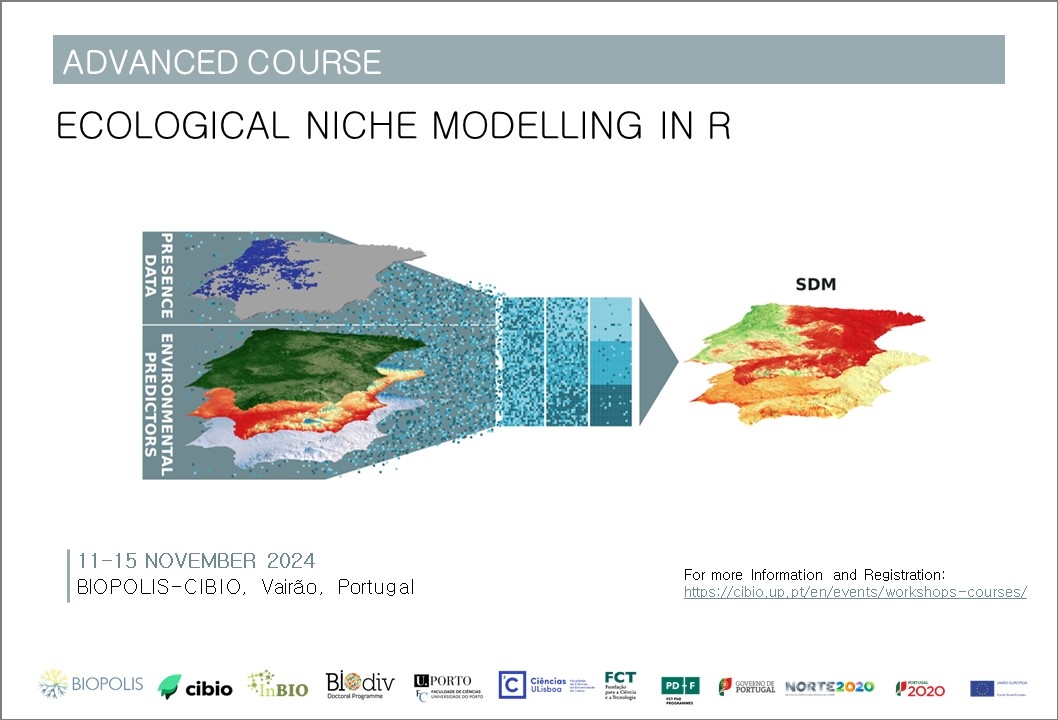Ecological Niche Modelling in R
Event
Ecological niche models (ENM), and/or species distribution models (SDM), are a series of computer algorithms designed to predict the distribution of species in geographic space based on a mathematical representation of their distribution in the environmental space. These state-of-the-art tools are frequently used in different biological disciplines such as ecology, biogeography, evolutionary biology or conservation. This course is aimed to provide, in a R environment: (1) an overview of the theoretical aspects, applications and techniques of ENM, and (2) a series of practical cases exemplifying relevant scientific uses of ENM.
November 11th, 2024
BIOPOLIS-CIBIO, Vairão, Portugal (Face-to-face)

Ecological niche models (ENM), and/or species distribution models (SDM), are a series of computer algorithms designed to predict the distribution of species in geographic space based on a mathematical representation of their distribution in the environmental space. These state-of-the-art tools are frequently used in different biological disciplines such as ecology, biogeography, evolutionary biology or conservation. This course is aimed to provide, in a R environment: (1) an overview of the theoretical aspects, applications and techniques of ENM, and (2) a series of practical cases exemplifying relevant scientific uses of ENM.
Requirements: students should have basic experience in R.
PROGRAM
Day 1
Morning
1.0 Overview of the program
1.1 What is the niche?
1.2 The Ideal Ecological Niche Model
1.3 Data sources for species observations and predictor variables
Afternoon
1.4 Spatial data and common formats
1.5 Practical - Importing and mapping observations and variables; delimiting the study area.
Day 2
Morning
2.1 Diversity of algorithms - Presence-absence
2.2 Diversity of algorithms - Presence-only
2.3 Diversity of algorithms - Presence-background
Afternoon
2.4. Practice - BIOCLIM
2.5. Practice – MaxEnt (predicts / maxnet)
2.6. Practice - GLM
Day 3
Morning
3.1 Model evaluation
3.2 Practice - model evaluation
Afternoon
3.3 Ensemble forecasting
3.4. Practice –Multimodelling platform
Day 4
Morning
4.1 Model comparison – Null hypothesis testing
4.2 Practice – Niche comparison tests
Afternoon
4.3 Projection in time (past, future) and space
4.4 Practice – dissimilarity surfaces
4.5 Practice – model projection/ biomod
Day 5
Students' presentations and evaluations. Other topics and questions.
CALENDAR
5 days - 32h (Friday only in the morning) - Schedule: 09:30 - 13:00 & 14:00 - 17:30
COURSE INSTRUCTORS
Coordination
Fernando Martínez Freiría | BIOPOLIS/ CIBIO-InBIO
Instructors
Pedro Tarroso | BIOPOLIS/ CIBIO-InBIO
A. Márcia Barbosa | NA
Urtzi Enríquez Urzelai | Institute of Vertebrate Biology, Czech Academy of Sciences
SELECTION CRITERIA
The course will be open to a maximum number of 20 participants.
75% of available student slots are reserved for BIODIV students.
Priority will be given to:
• 1st year and other PhD students attending the BIODIV Doctoral Program;
• PhD students attending other courses;
• Other post-graduate students and researchers.
(A minimum number of participants is required for the course to take place)
APPLICATION
Deadline: 14 October 2024
To apply fill the FORM
A copy of the form will be sent to the email address you provide as proof that you have successfully submitted your application. Results will be emailed to you within 8 working days of the application deadline.
REGISTRATION
95€ (students) | 200€ (other participants).
BIOPOLIS/ CIBIO members will have an additional discount of 20%. Participation is free of charge for BIODIV Students MBGE 1st year Students & CIBIO's TwinLabs
(If applicable, payment will be made to Associação BIOPOLIS - VAT No. 516033727. Information on the payment amount and the payment deadline will be sent together with the results notification, and a proforma invoice may be issued in due time).
MORE INFORMATION
Registration fees do not include accommodation or meals.
No ECTS credits are awarded for attending the course. Participants receive a certificate of attendance without quantitative evaluation.
